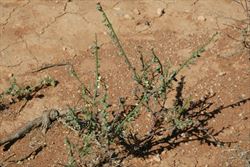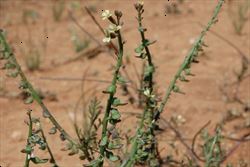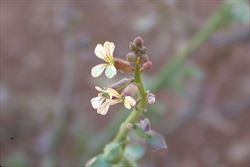Click on images to enlarge

habit (Photo: David Albrecht)

habit (Photo: Rob and Fiona Richardson)

stems and deeply-divided leaves (Photo: David Albrecht)

close-up hairy stem and leaf underside (Photo: Dave Albrecht)

elongated flower clusters with fruit beginning to develop (Photo: Rob and Fiona Richardson)

flowers (Photo: Rob and Fiona Richardson)

close-up of flowers from side-on (Photo: Rob and Fiona Richardson)

close-up of immature fruit (Photo: Rob and Fiona Richardson)
Scientific Name
Carrichtera annua (L.) DC.
Synonyms
Vella annua L.
Family
Brassicaceae (Queensland, New South Wales, the ACT, Victoria, Tasmania, Western Australia and the Northern Territory)Cruciferae (South Australia)
Common Names
Ward's weed
Origin
Native to some parts of the Mediterranean region (i.e. Morocco, Spain, Italy, Greece) and western Asia (i.e. Iraq and Iran).
Cultivation
An accidental introduction and not deliberately cultivated in Australia.
Naturalised Distribution
Widely naturalised, particularly in the inland regions of southern Australia. It is widespread in South Australia and in the southern and central parts of Western Australia (i.e. particularly in the Goldfields and Nullarbor shrublands from Laverton to Eucla). Less common or occasionally naturalised in western New South Wales, in some parts of Victoria and in the southern parts of the Northern Territory. Also sparingly naturalised in Tasmania and was naturalised in some parts of southern and central Queensland (i.e. has not been recorded in Queensland for more than 50 years).
Habitat
A weed of rangelands, grasslands, open woodlands, pastures, disturbed sites, and waste areas in semi-arid regions. Less common in wetter temperate regions.
Habit
A small, upright (i.e. erect) to spreading (i.e. decumbent), short-lived (i.e. annual) herbaceous plant usually growing only 5-40 cm tall.
Distinguishing Features
- a small short-lived plant usually growing only 5-40 cm tall.
- the stems, leaves and fruit are covered bristly hairs.
- the leaves (up to 10 cm long) are deeply divided into several narrow lobes.
- the yellowish flowers have four petals (8-9 mm long) with purple veins.
- the small fruit (6-8 mm long) are held in a drooping position and are topped with a spoon-shaped projection.
Seedling
The two seed leaves (i.e. cotyledons) are kidney-shaped (i.e. reniform), with an indented tip (i.e. emarginate apex), and are borne on relatively long stalks (i.e. petioles). The first true leaves are deeply divided (i.e. pinnatisect) and have hairy stalks (i.e. hispid petioles).
Stems and Leaves
The stems are covered with backwards pointing (i.e. reflexed) bristly hairs (i.e. they are hispid) and often produce several side-branches near the base of the plant.
The simple leaves (up to 10 cm long) are alternately arranged along the stems and borne on stalks (i.e. petioles). These leaves are deeply divided (i.e. bipinnatisect or tripinnatisect) into several narrow (i.e. linear) lobes. They also have a sparse covering of bristly hairs (i.e. they are hispid).
Flowers and Fruit
The flowers are borne in elongated clusters that emerge from the leaf forks near the tips of the stems (i.e. in axillary racemes) 1-3 cm or more long. Each flower has four green sepals (4-4.5 mm long) that are held in an upright (i.e. erect) position and four larger petals (8-9 mm long). These petals are yellowish in colour with purple veins. The flowers also have six stamens and a leafy style topped with a single stigma. Flowering occurs mostly during winter and spring (i.e. from June to November).
The small fruit (6-8 mm long) are borne on short stalks (i.e. pedicels) 2-3 mm long and are held in a drooping position (i.e. they are pendent). They resemble small pods (actually a silicula), split open when mature (i.e. they are dehiscent), and are divided into two segments. The upper segment does not contain any seeds and is flatenned (i.e. compressed) into a spoon-shaped projection (i.e. spathulate beak) 3-4 mm long and about 2-3 mm wide. The lower segment is somewhat rounded (i.e. sub-globose), stiffly hairy (i.e. hispid), and contains 3 or 4 seeds. The seeds are rounded (i.e. globose) and 1-1.5 mm long.
Reproduction and Dispersal
This species reproduces only by seed. These seeds are dispersed short distances by ants and other foraging animals. They may be dispersed longer distances by vehicles, on larger animals and clothing, and in contaminated aghricultural produce.
Environmental Impact
This species now dominates large areas of the semi-arid rangelands of southern Australia. It is regarded as a significant environmental weed in Victoria, South Australia and Western Australia, and is currently listed as a priority environmental weed in two Natural Resource Management Regions.
Ward's weed (Carrichtera annua) invades native grasslands and open woodlands, where it replaces long-lived (i.e. perennial) native species. In Western Australia it often also dominates mine rehabilitation sites and in South Australia it is a weed in conservation areas (e.g. Marino Conservation Park).
Other Impacts
Being a weed of rangelands and pastures, Ward's weed (Carrichtera annua) can significantly reduce the productivity of grazing areas. It is also a weed of crops in drier regions.
Legislation
Not declared or considered noxious by any state government authorities.
Similar Species
Ward's weed (Carrichtera annua) is similar to several of the native and introduced pepercresses (Lepidium spp.), particularly those with deeply divided leaves. However, the peppercresses (Lepidium spp.) generally have smaller flowers with white petals and their fruit do not have a projection.

